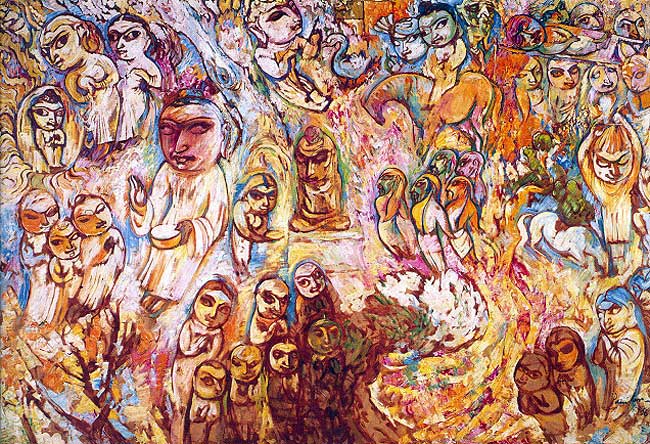. . . . . . . . . . . . . . . . . . . . . . . . . .
Stay Blue for Health and Go Green to Keep It
(Report by Appu Jacob John, June 2012)

'Lumbini' or 'The Life of Buddha' (1956) by KCS Paniker (1911–1977), one of the most renowned painters from Kerala.
The 20th Wellbeing Tibetan medical camp jointly organised by Friends of Tibet and Men-Tsee-Khang was conducted at Ashirbhavan, Ernakulam here from June 6-9, 2012. As always, the medical team did a tremendous service in providing health to the needy participants while Friends of Tibet remained instrumental in providing good coordination between the medical team and the participants. The June 2012 camp was a complete success in spite of a few odd sounds. In this report we shall discuss colours and what they signify.
For centuries colours, standards and banners were associated with the societies and associations. Here we discuss two colours — one is blue when the other is green. Blue is described as the colour of the medicine for Tibetans; while green is the colour of environment all over the world.
Blue is often considered inauspicious to health. In the Indian tradition blue is considered as the colour of poison. We have heard of Lord Siva called in as Neelkant after he had drunk the Kalakoota poison. In England blue signifies sadness. In German it means to be drunk. Blue is closely associated with depression. On the contrary many have also considered it as the colour of optimism as it represents open sky. Artists consider blue coloured clear skies symbolising happiness. It is also considered as the colour of Virgin Mary in traditional Christian iconography. Traditionally blue is considered as the colour of females. It is also considered as the national colour of Greece and Israel. Traditional Israelites use blue as part of their traditional attire. Blue also represents sereneness as it is part of the ocean.
Back in Tibet blue is considered the colour of Medicine. Tibetans consider Blue Buddha as the God of medicine. Here blue is considered as the colour of sereneness and health. It is like the wide-open blue skies; which invite one to enjoy good health.
Green is again another colour which is associated with growth in old English. Green at the same time is a slang signifying counterfeit currency. Culturally it is the colour of poison in western countries. It also depicts envy, love, lust, death and decay and devil in traditional Xian art. Traditionally, it has been the colour of environmental movements all over world representing growth and health. Besides it is always considered as the colour of fertility. Many nations including Gaddafi’s Libya have accepted green as their national colour to represent prosperity. Green is considered as the colour of health. The colour represents our concern for health care through nature care. We believe that health is only possible when we respect the health of the whole nature around.
This seems a difficult task for us. On the other hand it is easy as we just have to consider about the world around and just have to care for it. Then it becomes easy so that we can make the world a better place to live. Hence we say "Stay Blue for Health and Go Green to Keep It."
(Appu Jacob John is a Friends of Tibet Campaigner and a writer based in Kerala, South India. He can be reached at appu.john@friendsoftibet.org)
. . . . . . . . . . . . . . . . . . . . . . . . . .
| Home |
Friends of Tibet is a people's movement to keep alive the issue of Tibet through direct action. Our activities are aimed at ending China's occupation of Tibet and the suffering of the Tibetan people. Friends of Tibet supports the continued struggle of the Tibetan people for independence. Friends of Tibet is also one of the principal organisers of World Tibet Day around the world.
